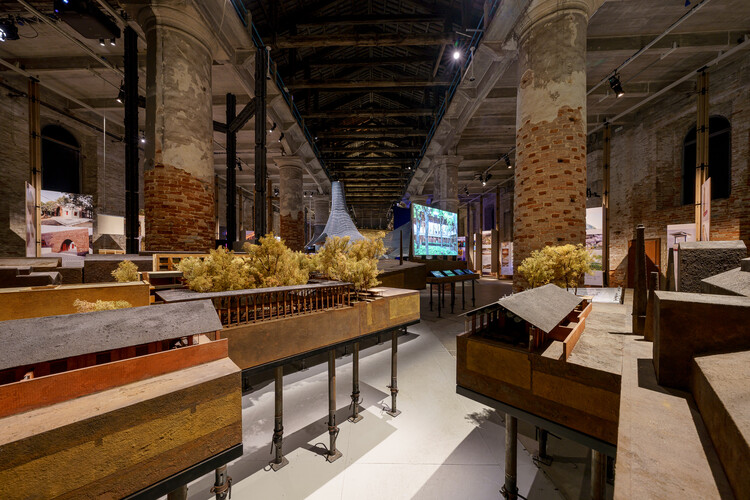 Corderie dell’Arsenale. Image © Andrea Avezzù, Courtesy of la Biennale di Venezia
Corderie dell’Arsenale. Image © Andrea Avezzù, Courtesy of la Biennale di Venezia
Share
Share
Or
https://www.archdaily.com/1031098/an-unfolding-crisis-with-a-hopeful-outlook-highlights-from-the-projects-exhibited-at-venice-architecture-biennale-2025
Under Carlo Ratti’s curatorship, the Venice Biennale’s 19th International Architecture Exhibition delves into the theme “Intelligens. Natural. Artificial. Collective,” with the explicit aim of transforming the city of Venice into a “Living Laboratory.” In addition to the 65 national participations and a wide range of educational and collateral events, the exhibition features independent projects that directly respond to the overarching theme. With most of the exhibits showcased in the historic Corderie building, stretching along the south side of the Arsenale, the event offers a dynamic exploration of emerging architectural ideas and urban strategies.
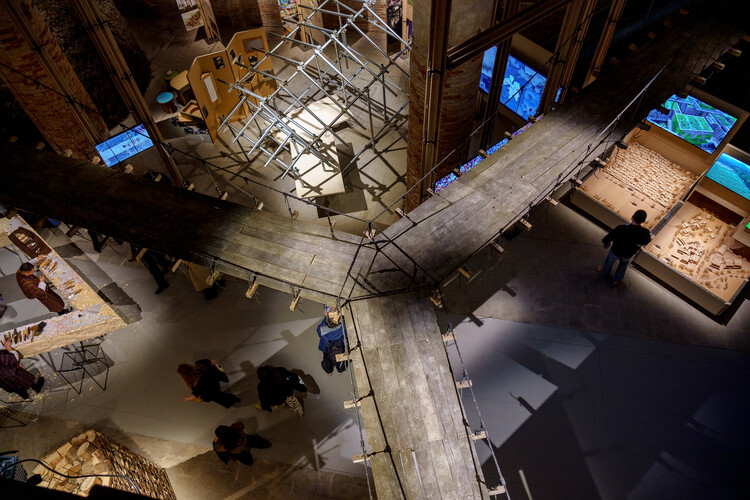 Corderie dell’Arsenale. Image © Andrea Avezzù, Courtesy of la Biennale di Venezia
Corderie dell’Arsenale. Image © Andrea Avezzù, Courtesy of la Biennale di Venezia
In a break from the curatorial tradition of the Venice Architecture Biennale, curator Carlo Ratti decided to open up the selection process by inviting practitioners from all around the world to participate in the open call, “Space for Ideas“. Global teams, from Pritzker Prize winners and Nobel laureates to emerging architects and scientists, submitted their projects between May and June 2024, resulting in a selection of 305 projects developed by over 750 participants from diverse backgrounds, including architects, engineers, mathematicians, climate scientists, and artists. This represents one of the largest numbers of invited participants to contribute to the International Architecture Exhibition, further highlighting the curator’s intention for this edition to provide a platform for interdisciplinary collaboration.
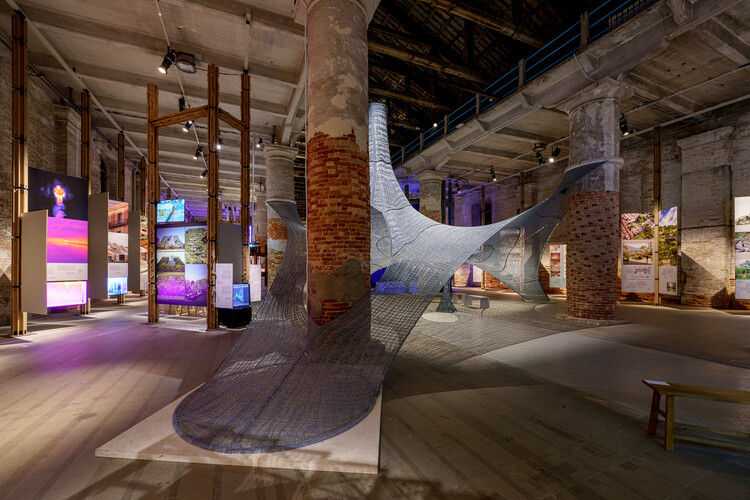 Corderie dell’Arsenale. Image © Andrea Avezzù, Courtesy of la Biennale di Venezia
Corderie dell’Arsenale. Image © Andrea Avezzù, Courtesy of la Biennale di Venezia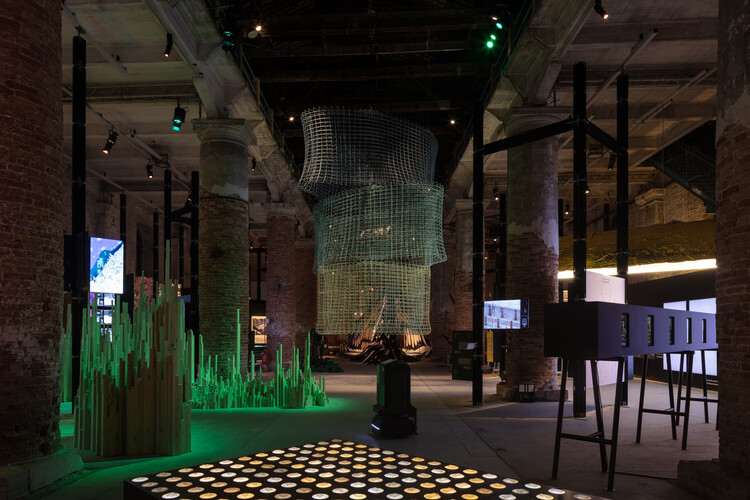 A Robot’s Dream / Gramazio Kohler Research, ETH Zurich, MESH, Studio Armin Linke. Image © Luca Capuano, Courtesy of La Biennale di Venezia
A Robot’s Dream / Gramazio Kohler Research, ETH Zurich, MESH, Studio Armin Linke. Image © Luca Capuano, Courtesy of La Biennale di Venezia
Alternating between familiar and futuristic, many of the participants envision a future not as tabula rasa, not a futuristic vision disconnected from existing realities, but as a version of the present where challenges are addressed and turned into opportunities. Some of the exhibits showcase how ancient rituals can find a space within technologically intensive practices, others reframe waste and by-products as hidden opportunities, while also placing focus on the need for both environmental and social restoration through collective work.
Related Article Discover the Full List of Special Projects and Participants of the 2025 Venice Architecture Biennale
The exhibition is divided into 3 main sections, reflecting the title of the theme: Natural, calling for architectures reintegrated within natural systems; Artificial, exploring the potential of generative models and emerging technologies; and Collective, blending local and global directions in a showcase of mutual learning and exchange. The sheer number of exhibits in each section creates a dynamic experience. At its best, this overlapping of ideas and media can lead to unexpected and enriching connections. At its worst, however, it introduces a level of dissonance and confusion. In one example, a somber presentation of a war-torn Ukraine can be intermittently interrupted by the joyful sounds of a little robot imitating visitors banging on a drum. Perhaps a reflection of the multifaceted nature of contemporary architecture, the exhibition demonstrates a complex interdisciplinary dialogue, with several themes emerging above the three pre-established sections.
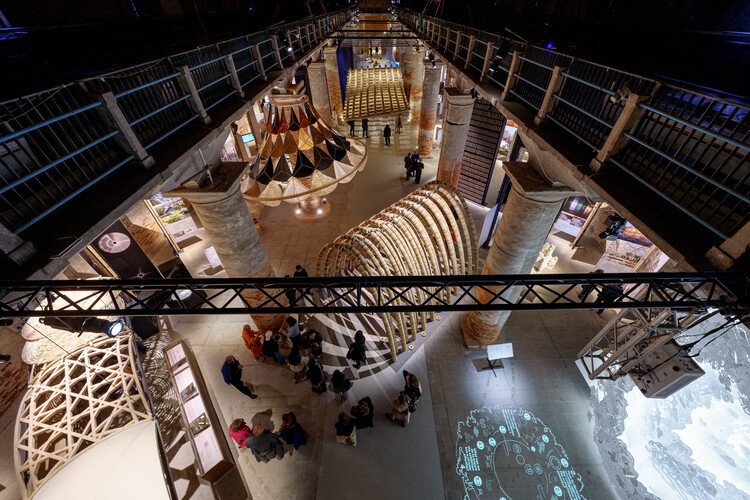 Corderie dell’Arsenale. Image © Andrea Avezzù, Courtesy of la Biennale di VeneziaArticulating the Emergency
Corderie dell’Arsenale. Image © Andrea Avezzù, Courtesy of la Biennale di VeneziaArticulating the Emergency
Upon entering the Corderie dell’Arsenale, the first room creates an experience so immersive it borders on uncomfortable, in a very intentional way. The “Terms and Conditions” installation reverts the usually climate-controlled interiors of buildings by showcasing the effects that cooling systems have on the outside. The team, composed of Transsolar, Bilge Kobas, Daniel A. Barber, and Sonia Seneviratne, creates a hot and humid environment, pointing to the “fine print” of the environmental negotiation, the often-overlooked effects of the systems we use for comfort.
In the same space, “The Third Paradise Perspective” by Fondazione Pistoletto Cittadellarte introduces rings of light reflecting onto the pools, symbolizing a collaborative path that leads out of this difficult context. This combined effect of the two installations offers an early preview of the overarching message of the Exhibition: presenting the dire consequences of changing environments and conflict, but presenting it from an optimistic perspective, looking for applied solutions for adaptations and improvements.
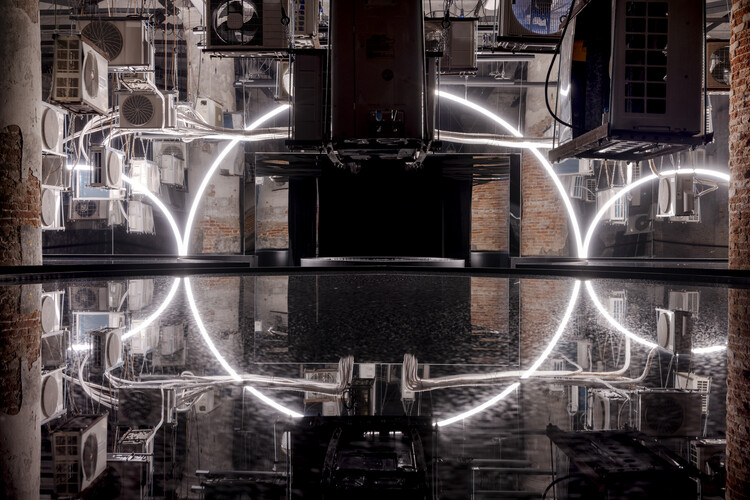 The Third Paradise Perspective / Fondazione Pistoletto Cittadellarte. Image © Marco Zorzanello, Courtesy of La Biennale di VeneziaBridging the Ancient, the Natural, and the Technological
The Third Paradise Perspective / Fondazione Pistoletto Cittadellarte. Image © Marco Zorzanello, Courtesy of La Biennale di VeneziaBridging the Ancient, the Natural, and the Technological
Despite the separation into the 3 sections, several of the projects demonstrate the connections between these elements, linking ancestral and indigenous knowledge embedded into its natural context with emerging technologies aimed at capturing and heightening this complex interplay. One such example is “Stonecrust: The Microbeplanetary Infrastructure of Lithoecosystems” led by Andrés Jaque / Office for Political Innovation and Gokce Ustunisik. It listens to Indigenous cultures and their perspective of stone ecosystems to rearticulate this apparently passive material as an active ecosystem, one that can inform and contribute to more sustainable practices.
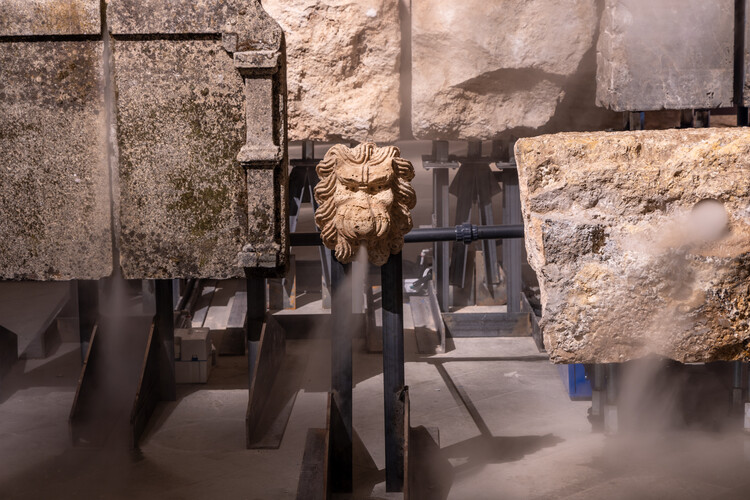 Stonecrust: The Microbeplanetary Infrastructure of Lithoecosystems / Andrés Jaque / Office for Political Innovation Gokce Ustunisik. Image © Marco Zorzanello, Courtesy of La Biennale di Venezia
Stonecrust: The Microbeplanetary Infrastructure of Lithoecosystems / Andrés Jaque / Office for Political Innovation Gokce Ustunisik. Image © Marco Zorzanello, Courtesy of La Biennale di Venezia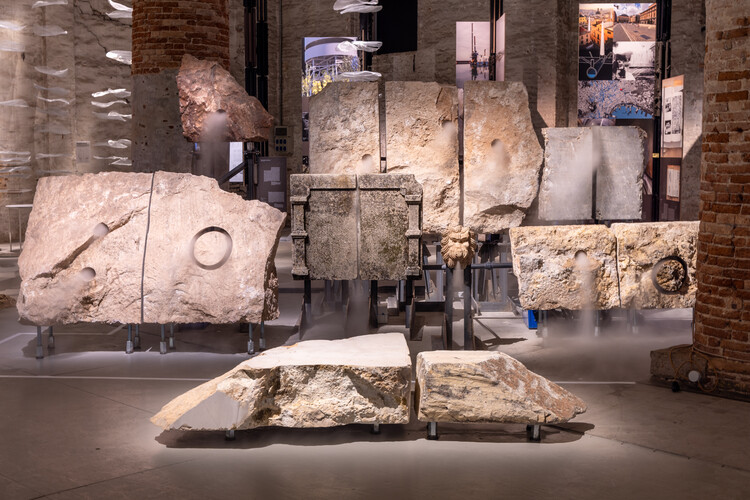 Stonecrust: The Microbeplanetary Infrastructure of Lithoecosystems / Andrés Jaque / Office for Political Innovation Gokce Ustunisik. Image © Marco Zorzanello, Courtesy of La Biennale di Venezia
Stonecrust: The Microbeplanetary Infrastructure of Lithoecosystems / Andrés Jaque / Office for Political Innovation Gokce Ustunisik. Image © Marco Zorzanello, Courtesy of La Biennale di Venezia
Exploring a different aspect, “The Storm: Architectures of Vernacular Geoengineering” by Eva Franch i Gilabert and Jose Luis de Vicente highlights traditional community practices in climate adaptation, blending indigenous knowledge with future architectural visions. Meanwhile, “Bringing Back the Past, Another Way of Looking Into the Future” by Peter Pichler Architecture advocates for low-tech, context-sensitive solutions rooted in local culture and ecology.
AI Imitating Life
Poised in the middle of the exhibition space, a captivating exhibit presents two Bhutanese craftsmen carefully chiseling two large wooden beams with intricate designs, while behind them, an AI-driven robotic arm smooths over the two other decorated beams, the ones it has already finished to cold perfection. Titled “Ancient Future: Bridging Bhutan’s Tradition and Innovation,” the exploration is the result of a collaboration between BIG, Laurian Ghinitoiu, and Arata Mori, exploring a different facet of BIG’s design for the Gelephu International Airport in Bhutan. An unspoken question arises from the parallel crafting techniques: which one is better? The personalized manual labor-intensive version, where each mark is still visible in the final product, or the quicker automated version, smooth and precise?
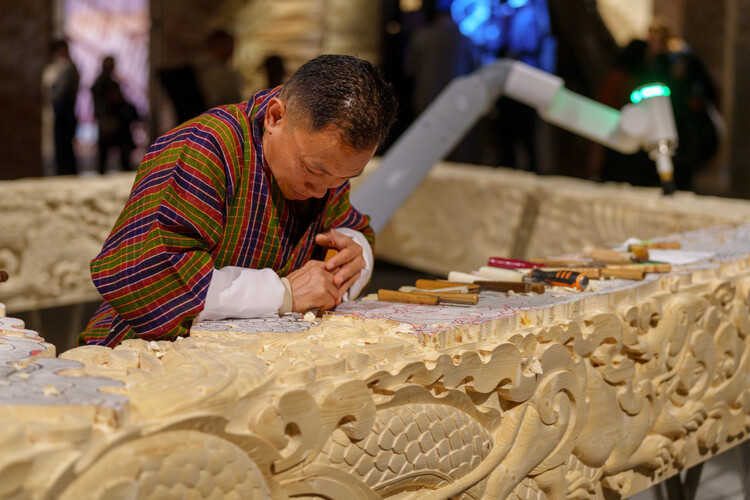 Ancient Future: Bridging Bhutan’s Tradition and Innovation / Bjarke Ingels Group, Laurian Ghinitoiu, Arata Mori. Image © Andrea Avezzù, Courtesy of la Biennale di Venezia
Ancient Future: Bridging Bhutan’s Tradition and Innovation / Bjarke Ingels Group, Laurian Ghinitoiu, Arata Mori. Image © Andrea Avezzù, Courtesy of la Biennale di Venezia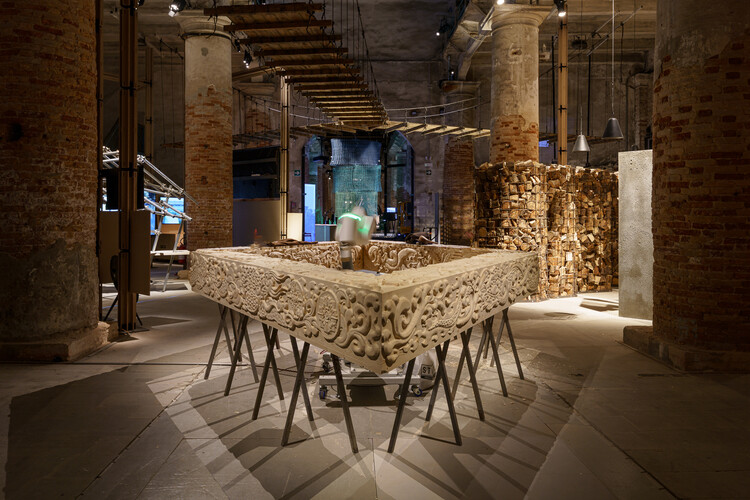 Ancient Future: Bridging Bhutan’s Tradition and Innovation / Bjarke Ingels Group, Laurian Ghinitoiu, Arata Mori. Image © Andrea Avezzù, Courtesy of la Biennale di Venezia
Ancient Future: Bridging Bhutan’s Tradition and Innovation / Bjarke Ingels Group, Laurian Ghinitoiu, Arata Mori. Image © Andrea Avezzù, Courtesy of la Biennale di Venezia
AI imitations prove to be a recurring subject across multiple projects, raising questions about the purposes of AI-driven robotics. Several robots are on show in the exhibition, from anthropomorphic machines that replicate human actions or mimic expressions while answering questions to prove their self-awareness, to a wandering AI agent sent out to the streets of Venice to provide information about the Biennale and predict crowd behaviors. Installations such as “Machine Mosaic” aim to position robotics as a tool, rather than a replica, but the fascination with their capabilities clearly underscores a broader dialogue about the relationship between human craftsmanship and technological advancement.
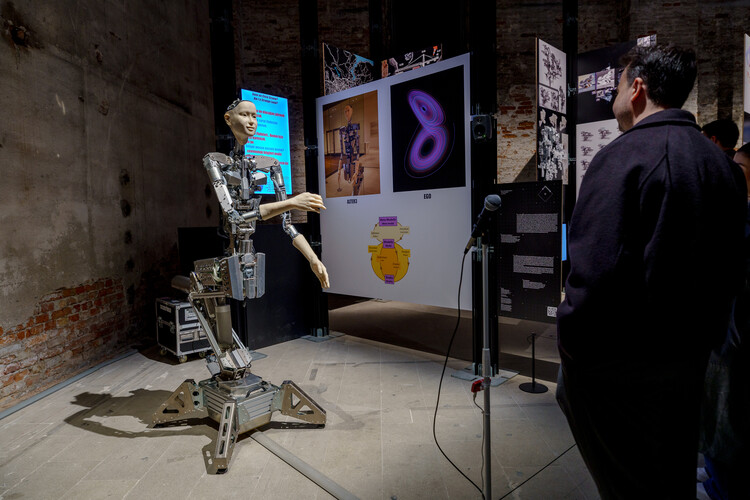 Am I a Strange Loop? / Takashi Ikegami, Luc Steels . Image © Andrea Avezzù, Courtesy of la Biennale di Venezia
Am I a Strange Loop? / Takashi Ikegami, Luc Steels . Image © Andrea Avezzù, Courtesy of la Biennale di Venezia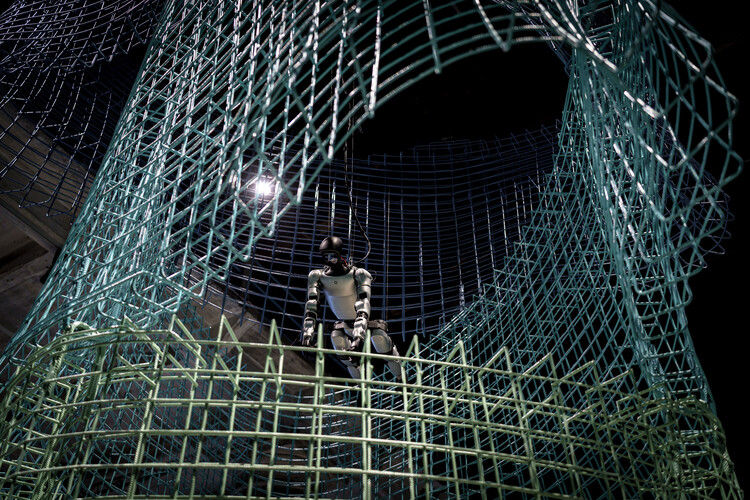 A Robot’s Dream / Gramazio Kohler Research, ETH Zurich, MESH, Studio Armin Linke. Image © Andrea Avezzù, Courtesy of la Biennale di VeneziaThe City as a Natural Resource
A Robot’s Dream / Gramazio Kohler Research, ETH Zurich, MESH, Studio Armin Linke. Image © Andrea Avezzù, Courtesy of la Biennale di VeneziaThe City as a Natural Resource
Material scarcity is a recurrent theme, both inside the Biennale and across the building sector at large. As extractive practices threaten ecological balance, as well as social and economic safety, participants are looking for alternatives. Concentrating so much of the built environment, the city emerges as an intuitive, yet often overlooked resource. Projects such as “Resourceful Intelligence” map the availability of resources within urban areas, exemplifying the process through two examples set in Milan that use selective deconstruction to recover reusable resources such as renewed glass and clinker tiles.
A similar approach, yet set in a completely different context, is “Circularity on the Edge.” It presents a specially created AI that is able to identify debris and materials in war-torn areas of Ukraine. It identifies both opportunities, materials that can be salvaged and reused, and obstacles in the form of hazardous materials such as asbestos slats. Its aim is to contribute actively to community-driven actions of reconstruction and remembrance.
In a different interpretation of the theme, the winner of the Golden Lion for Best Participation, “Canal Café” takes water directly from the Venetian lagoon, filters it via a set of algae-filled cylinders hoisted up on a metallic structure, all to create a cup of coffee as locally-sourced as possible. By imitating tidal wetlands and their cleansing properties, its creators, led by Diller Scofidio + Renfro, aim to highlight both water scarcity issues and their potential eco-inspired solutions.
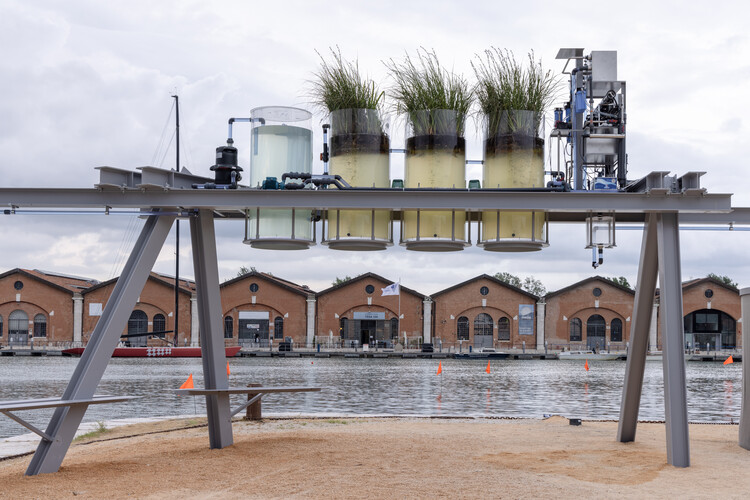 Canal Café / Diller Scofidio + Renfro, Natural Systems Utilities, SODAI, Aaron Betsky, Davide Oldani. Image © Marco Zorzanello, Courtesy of La Biennale di VeneziaTurning Challenges into Opportunities
Canal Café / Diller Scofidio + Renfro, Natural Systems Utilities, SODAI, Aaron Betsky, Davide Oldani. Image © Marco Zorzanello, Courtesy of La Biennale di VeneziaTurning Challenges into Opportunities
The idea of looking for opportunities in the most difficult or controversial issues is not limited, however, to urban environments. From elephant dung or invasive plant species to expansive data centers, designers are searching not only for solutions, but for opportunities for innovation. Boonserm Premthada explore the use of elephant by-products to create stable bricks, demonstrating their structural capabilities with “Elephant Chapel“, Kengo Kuma and collaborators transform fallen trees from Storm Vaia into resilient building elements with the use of AI in the installation Domino 3.0: Generated Living Structure,” while “Soft Infrastructure” utilizes invasive reeds to promote environmental restoration. At a different scale, “Data Centres and the City” explores the possibilities of reintegrating data centers within urban environments, transforming them from hidden infrastructure to community assets.
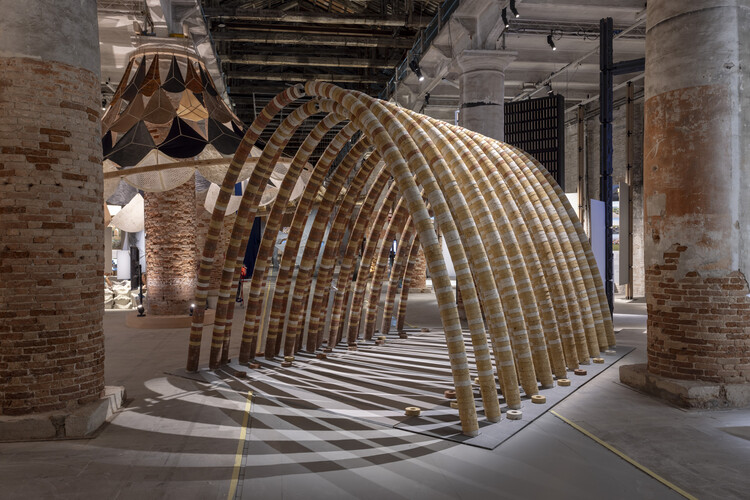 Elephant Chapel / Boonserm Premthada. Image © Marco Zorzanello, Courtesy of La Biennale di Venezia
Elephant Chapel / Boonserm Premthada. Image © Marco Zorzanello, Courtesy of La Biennale di Venezia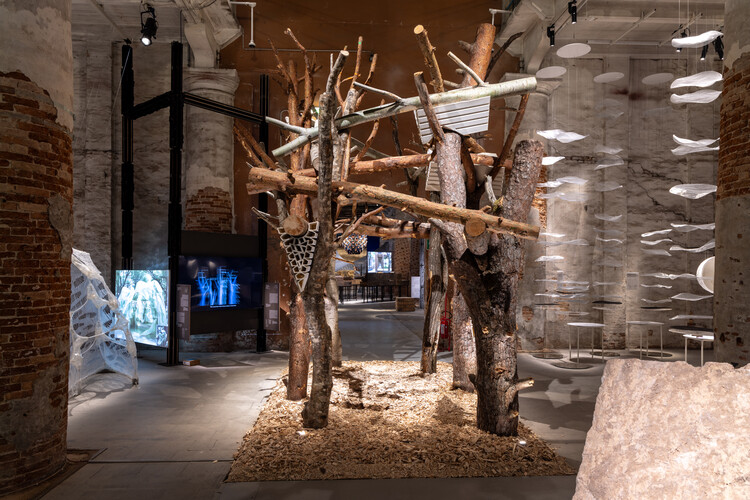 Domino 3.0: Generated Living Structure / Kengo Kuma, SEKISUI HOUSE – KUMA LAB, The University of Tokyo, Yutaka Matsuo, Matsuo – Iwasawa Lab, The University of Tokyo, Norihiro Ejiri, Ejiri Structural Engineers, Minoru Yokoo, Kengo Kuma & Associates. Image © Marco Zorzanello, Courtesy of La Biennale di VeneziaFramework of Restoration and Social Responsibility
Domino 3.0: Generated Living Structure / Kengo Kuma, SEKISUI HOUSE – KUMA LAB, The University of Tokyo, Yutaka Matsuo, Matsuo – Iwasawa Lab, The University of Tokyo, Norihiro Ejiri, Ejiri Structural Engineers, Minoru Yokoo, Kengo Kuma & Associates. Image © Marco Zorzanello, Courtesy of La Biennale di VeneziaFramework of Restoration and Social Responsibility
Beyond materials and technologies, several of the participants have used the opportunity of this exhibition to advocate for widespread practices that prioritize restoration and renovation, and give more attention to the social implications of the construction field. Among these, the European Citizens’ Initiative “HouseEurope!” advocates for EU legislation to promote the renovation and transformation of existing buildings over demolition. “The Ritual, The Void, The Repair” by Limbo Accra reimagines Senegal’s unfinished Ndiouga Kébé Palace, reflecting on modernity’s legacy and decay, while the ” Rwanda Institute for Conservation Agriculture” offers an alternative model for agriculture in the East African region.
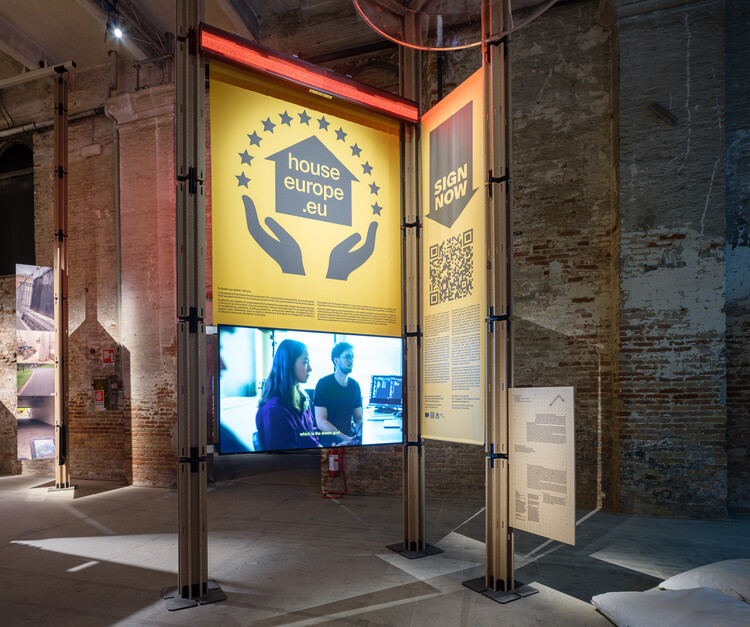 HouseEurope! / HouseEurope!, s+ (station.plus, D-ARCH, ETH Zurich), b+ Prototypen, CCA – Canadian Centre for Architecture. Image © Andrea Avezzù, Courtesy of la Biennale di Venezia
HouseEurope! / HouseEurope!, s+ (station.plus, D-ARCH, ETH Zurich), b+ Prototypen, CCA – Canadian Centre for Architecture. Image © Andrea Avezzù, Courtesy of la Biennale di Venezia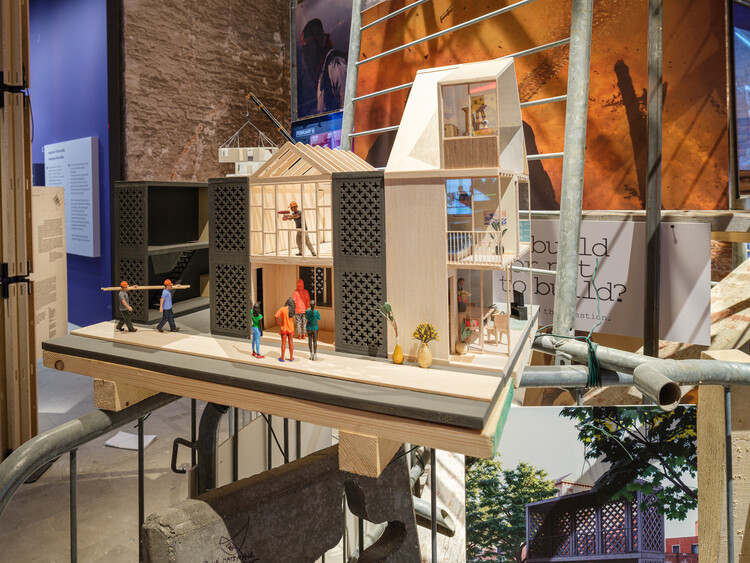 From Belongings to Belonging / ELEMENTAL. Image © Andrea Avezzù, Courtesy of la Biennale di Venezia
From Belongings to Belonging / ELEMENTAL. Image © Andrea Avezzù, Courtesy of la Biennale di Venezia
Elemental‘s “From Belongings to Belonging” highlights the housing crisis across the globe and the unique role of concrete prefabrication in creating a framework for a collaborative solution. Similarly, Lina Ghotmeh—Architecture highlights the theme of labor under the title “10,000 Hours of Care,” presenting the work of 50 artisans who invested over 500,000 hours for the craftmanship of a façade, thus creating France’s first low-carbon positive-energy factory and demonstrating Malcolm Gladwell’s 10,000-hour rule as the required time to truly master a skill.
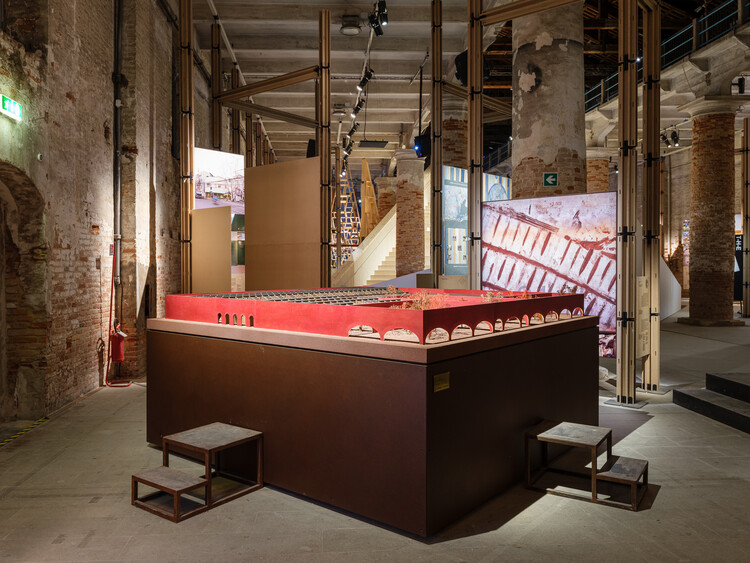 10,000 Hours of Care / Lina Ghotmeh—Architecture . Image © Andrea Avezzù, Courtesy of la Biennale di Venezia
10,000 Hours of Care / Lina Ghotmeh—Architecture . Image © Andrea Avezzù, Courtesy of la Biennale di Venezia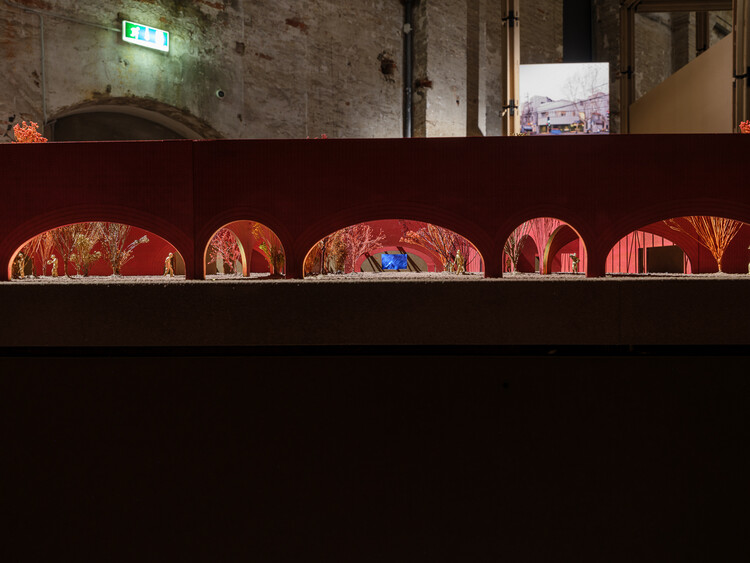 10,000 Hours of Care / Lina Ghotmeh—Architecture . Image © Andrea Avezzù, Courtesy of la Biennale di Venezia
10,000 Hours of Care / Lina Ghotmeh—Architecture . Image © Andrea Avezzù, Courtesy of la Biennale di Venezia
Overall, the exhibition provides a plethora of innovations, through exercises and calls to action, addressing everything from global challenges to hidden opportunities in niche domains. It showcases the scale of a pressing problem, but also attempts to present the breadth of solutions available, some futuristic, but many rooted in practice and context. It also presents collaborations not only across mediums and techniques, but also across time, bringing together ancient and indigenous knowledge with generative models and artificial intelligence, while also highlighting the need to start implementing functional frameworks for both social and environmental restoration.
We invite you to check out ArchDaily’s comprehensive coverage of the 2025 Venice Biennale.
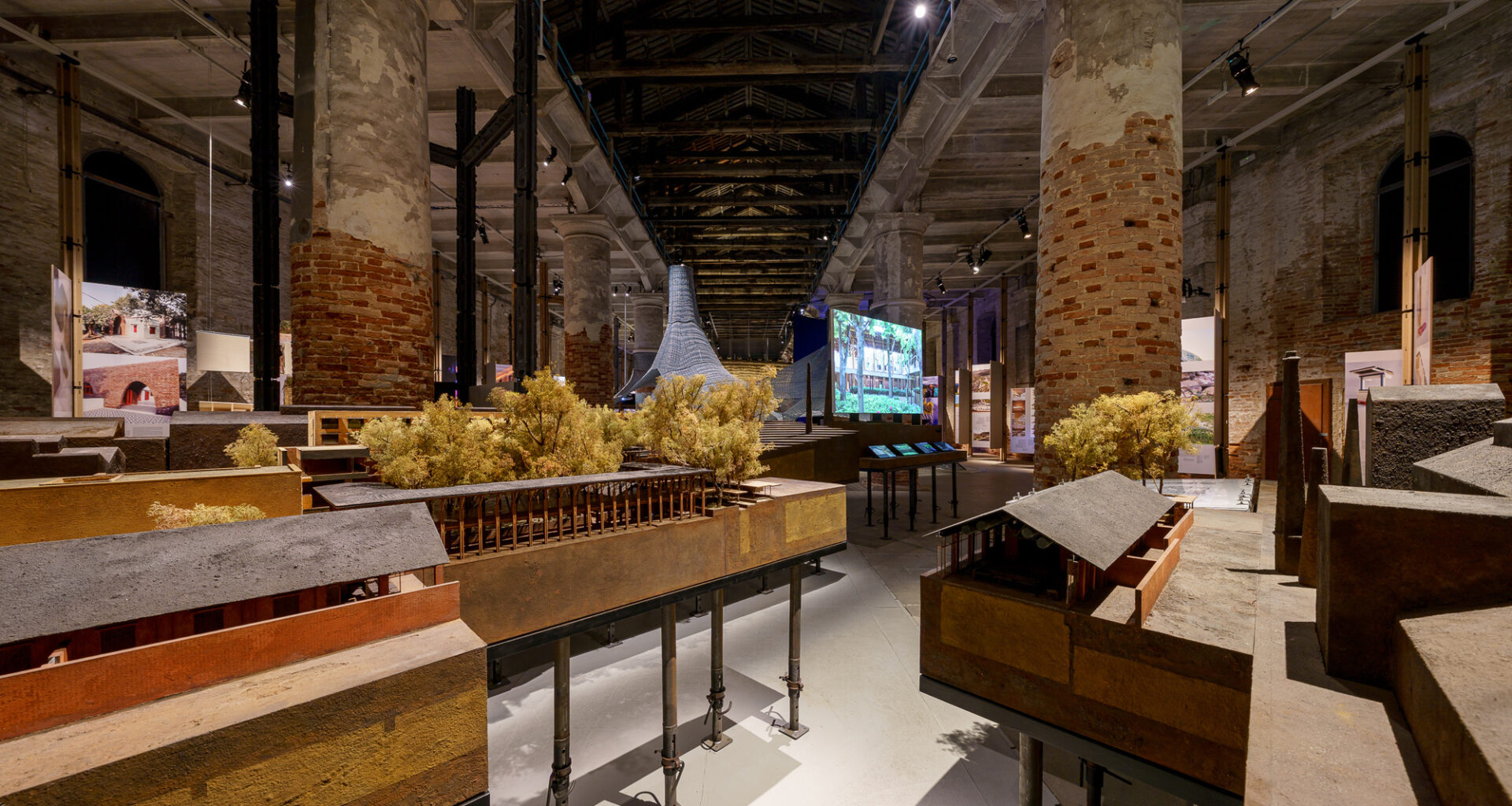
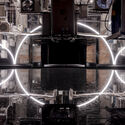
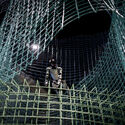
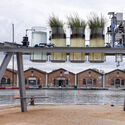

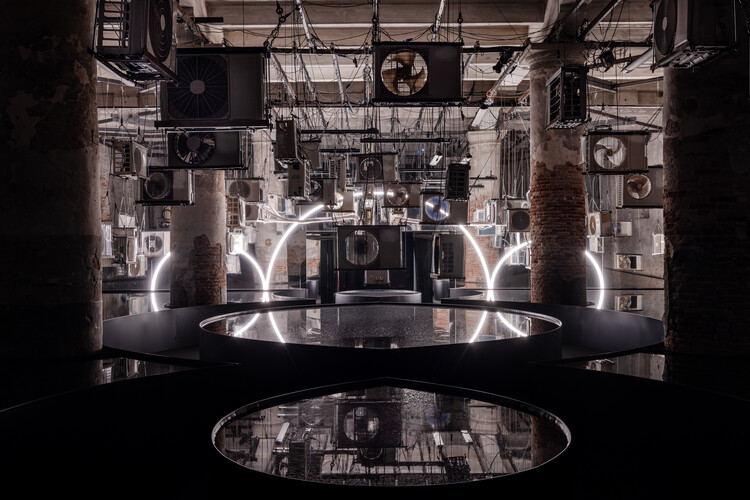 Terms and Conditions / Transsolar, Bilge Kobas, Daniel A. Barber. Image © Marco Zorzanello, Courtesy of La Biennale di Venezia
Terms and Conditions / Transsolar, Bilge Kobas, Daniel A. Barber. Image © Marco Zorzanello, Courtesy of La Biennale di Venezia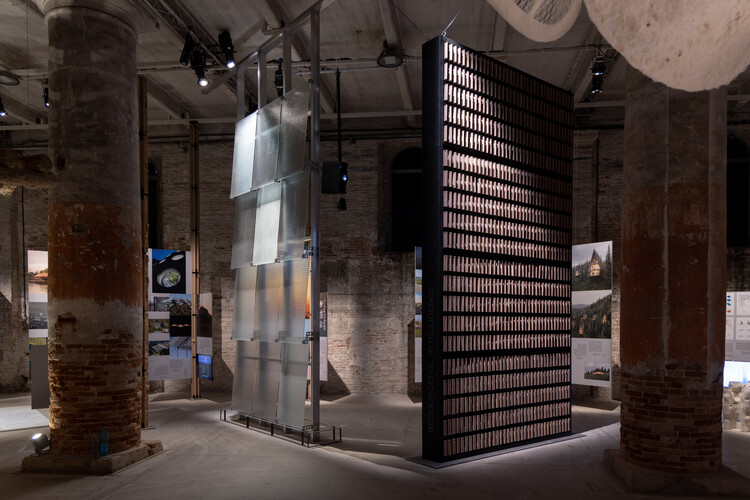 Resourceful Intelligence: Enhance Urban Mining in the Built Environment / Park, Accurat, Gabriele Masera, Department of Architecture, Built Environment and Construction Engineering, Politecnico di Milano, Francesco Pittau, Department of Architecture, Built Environment and Construction Engineering, Politecnico di Milano, Michele Versaci, Department of Architecture, Built Environment and Construction Engineering, Politecnico di Milano. Image © Marco Zorzanello, Courtesy of La Biennale di Venezia
Resourceful Intelligence: Enhance Urban Mining in the Built Environment / Park, Accurat, Gabriele Masera, Department of Architecture, Built Environment and Construction Engineering, Politecnico di Milano, Francesco Pittau, Department of Architecture, Built Environment and Construction Engineering, Politecnico di Milano, Michele Versaci, Department of Architecture, Built Environment and Construction Engineering, Politecnico di Milano. Image © Marco Zorzanello, Courtesy of La Biennale di Venezia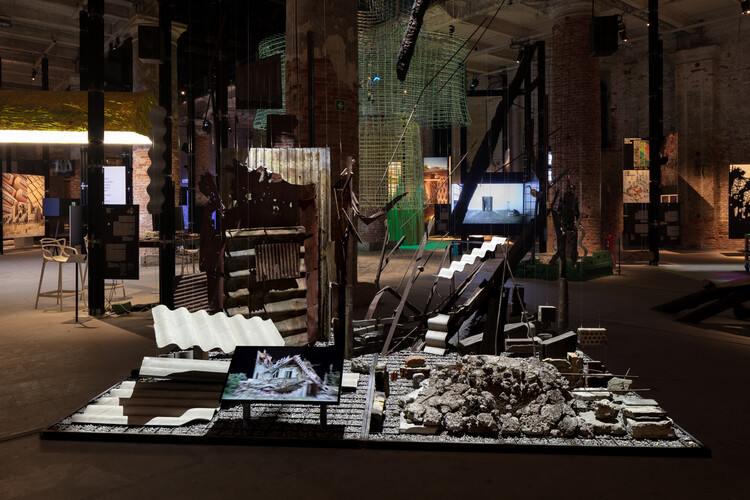 Circularity on the Edge / Kateryna Lopatiuk, Herman Mitish, Yana Buchatska, Orest Yaremchuk, Oleksandr Sirous, Roman Puchko. Image © Marco Zorzanello, Courtesy of La Biennale di Venezia
Circularity on the Edge / Kateryna Lopatiuk, Herman Mitish, Yana Buchatska, Orest Yaremchuk, Oleksandr Sirous, Roman Puchko. Image © Marco Zorzanello, Courtesy of La Biennale di Venezia